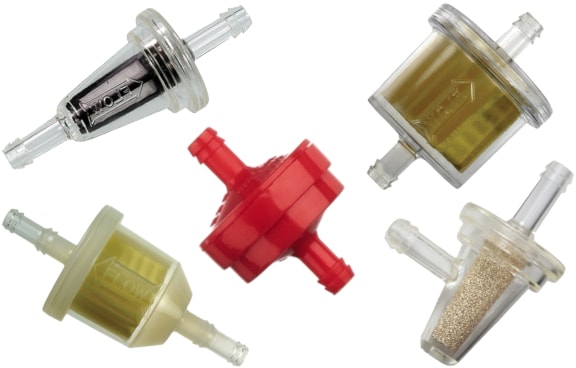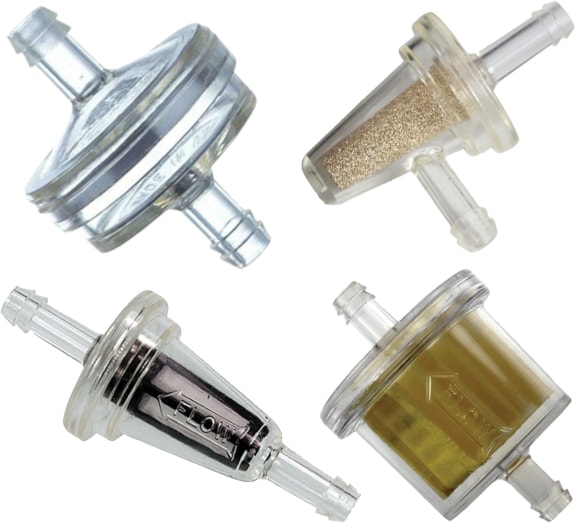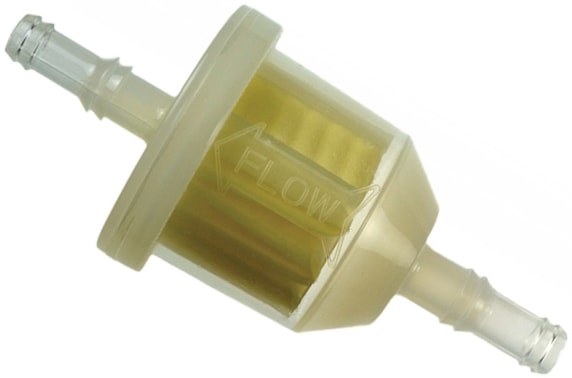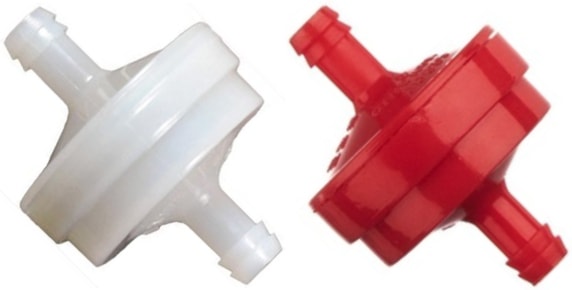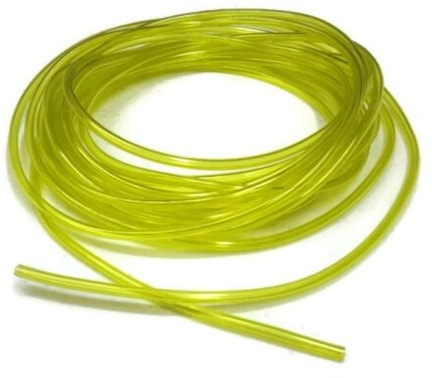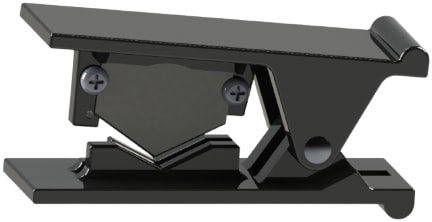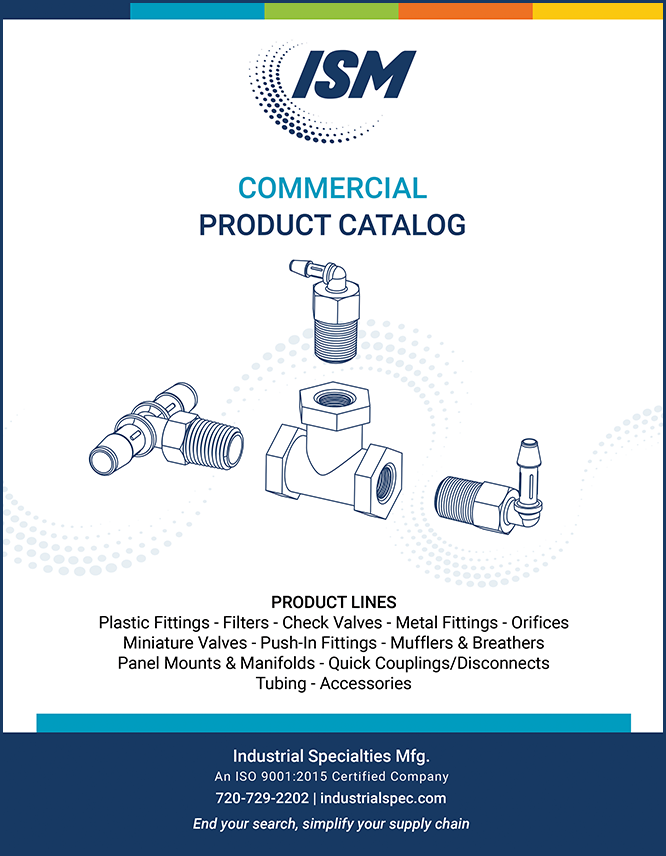Plastic Fuel Filter Body Materials
Quality plastic fuel filter housings should be durable, heat resistant and compatible with gasoline-ethanol blends
Published: February 8, 2021
Last updated: December 31, 2022
OE and OEM aftermarket small engine plastic inline fuel filtersSmall plastic inline fuel filters provide small or carbureted internal combustion (IC) engines with additional protection from particle contamination. If filtration is not present, this contamination can damage or reduce the performance of fuel system components like carburetors and fuel pumps.
Almost every internal combustion engine can benefit from using an easily replaceable fuel filter. Inline fuel filters are especially important for outdoor power equipment and powersports because of the dirty, dusty environments they operate in.
Most plastic inline fuel filters have a permanently welded housing or body that encloses a high flow rate filtering element. These filters use hose barbed inserts to connect the filter ends to flexible plastic or rubber fuel lines. These filters need to be robust and easily replaceable. Their simplicity of design and compact form, plus the additional protection they offer, is why they are so often used on outdoor power equipment and powersports small IC engines.
Choosing the right plastic material for a plastic filter body or housing is a critically important design decision. It helps ensure that plastic inline fuel filters are tough, durable and leak-free.
In-tank filters vs. external inline fuel filters
Note: Some small IC engines are so compact that they use in-tank filters. Chainsaws are a good example of this. A typical chainsaw does not have enough space available for an external fuel line let alone room for adding an inline fuel filter. This post discusses plastic inline fuel filters, not in-tank filters, which usually do not have external housings or bodies anyway.
Original equipment and addon inline fuel filters
Most powersports and outdoor power equipment come with a fuel filter already installed. If not, it might be present as an aftermarket addon. Whether an original equipment (OE) filter, an original equipment manufacturer (OEM) replacement part or an aftermarket addon, the quality of plastic inline fuel filters varies quite a bit. This is because of both the quality of the materials and the manufacturing processes used.
About ITW Visu-Filter plastic inline fuel filters
ITW Visu-Filter plastic inline fuel filters are made in North America at ITW Fastex Filtration and ITW Powertrain Components manufacturing sites and are ANSI/OPEI B71.10-2018 compliant. ITW is an OE and OEM supplier of automotive-grade components and sub-assemblies. Their automotive customers include major automobile and truck manufacturers and their tier suppliers.
Find out more about what OE, OER, OEM and ODM and mean for manufacturing at the ISM blog >>
This article looks at why it matters which plastics are used to make fuel filter housings. The focus is on how material choices by automotive-grade OEM manufacturers can affect filter performance.
For outdoor power equipment and powersports this is critical because there are new performance and reliability standards that make it easier to recognize the differences between quality OEM fuel filters and cheap knockoffs.
ITW Visu-Filter plastic inline fuel filters and ANSI testing standards
ITW Visu-Filter plastic inline fuel filters comply with the ANSI/OPEI B71.10-2018 standard.
If you like what you are reading..., please consider subscribing to our blog. You'll receive an email notification whenever we post a new article.
Outdoor power equipment and powersports internal combustion engines are smallerGenerally, transportable internal combustion (IC) engines are pretty low powered, especially when compared to automotive engines. Their designs sacrifice power for fuel efficiency and portability. As a power source, they tend to be about 30 horse power (hp) or less. They are also usually gasoline powered.
The choice of gasoline over diesel is based on the fact that diesel engines are much heavier and come at a significantly higher cost than gasoline-powered ones.
Transportable internal combustion powered tools can be roughly divided into two general categories: outdoor power equipment (chainsaws, weed trimmers, lawnmowers, log splitters, etc.) and powersports (go-karts, motocross, ATVs, snowmobiles, etc.).
Learn more about our products for the Small Engine marketplace >>
Rough operating conditions are a given for small IC enginesOutdoor power equipment (OPE) and powersports applications face many of the same challenges when it comes to fuel filtration:
- Rough handling and vibration
- Potential exposure to methanol*
- Potentially damaging particle contamination from dirty and dusty conditions
- Convenient user access to gasoline-ethanol blends such E10, E15 and E85 flex fuel
*Methanol and methanol-gasoline blends are used as specialized racing fuels. Racing methanol or racing alcohol are common names for pure methanol fuel that has not been blended with gasoline.
Everyday fuel system exposure to methanol is more likely to come in the form of gas tank additives. Methanol is the primary active ingredient in many over-the-counter fuel treatments for water contamination and to protect fuel lines from freezing.
Learn more about methanol fuel at Wikipedia >>
What are the features of a high-quality plastic inline fuel filter?The highest quality, most reliable plastic inline fuel filters come from specialty OEM filter manufacturers and reputable OEM small engine manufacturer parts suppliers. OEM manufacturers make these filters at scale and distributors, including parts suppliers, make them widely available.
The best OEM plastic fuel filters are made to automotive-grade standards. These OEM filters all have these characteristics in common:
- High heat-tolerance
- Tough, durable, impact and abrasion resistant
- Excellent chemical resistance, especially to hydrocarbon fuels
The bodies or housings of plastic inline filters and the filter elements inside them are especially challenged by the need to be compatible with the range of fuels and chemical additives that are most readily available to end users:
- Gasoline
- Gasohol blends like E10, E15 and E85 flex fuel
- Ethanol (ethyl alcohol), the alcohol used in gasohol blends
- Methanol (methyl alcohol), an alcohol that may sometimes be found in gasoline but generally is only used in specialty racing fuels
Why are manufacturers and machine designers willing to spend more to get high-quality OEM plastic inline fuel filters instead of using cheaper knockoffs?
Durability
OEM filter manufacturers choose engineering plastics like the PCTg version of PET, impact and heat modified nylon 6 and nylon 6,6 to make the highest quality plastic fuel filter housings. These plastics are consistently more heat resistant, more impact resistant and more abrasion resistant than commodity plastics. They also have significantly better chemical resistance than commodity plastics.
- Commodity plastics are considerably cheaper than engineering plastics
- Engineering plastics withstand conditions that commodity plastics cannot handle
High-quality OEM plastic fuel filters simply provide the best protection against fuel filter failure and fuel leaks.
Quality control
Just relying on engineering plastics isn’t enough though. The source of plastic raw materials matters just as much. Both suppliers and batches within a specific plastic can vary considerably in quality. Raw material may contain contaminated regrind or may even be off-spec to begin with.
Automotive-grade OEM filter manufacturers require consistency so they only source their raw plastics from reputable plastics manufacturers. OEMs also carry out their own quality control. They test the raw materials they use to be certain the plastics are up to spec.
Learn more about the differences between engineering plastics and commodity plastics at Wikipedia >>

The ultrasonic welding process simplified
The basic ultrasonic welding processSee the image above from left to right
1. The horn (blue) applies pressure (arrow) to the plastic materials to hold them together
2. The horn vibrates vertically between 20,000 to 40,000 times per second for a precise amount of time
3. The vibrations generated where the horn is focused cause the plastics there to melt, flow together and fuse after cooling
Reliability
Ultrasonic plastic welding is the manufacturing method of choice for assembling plastic inline fuel filters. Ultrasonic welds fuse the plastic components together to provide leak-proof seals that are stronger than the surrounding plastic itself. Engineering plastics require more precise manufacturing ultrasonic welding techniques specifically because of their strength and toughness.
Typical engineering plastics used for making plastic fuel filter housingsEngineering plastics used for fuel filter housings usually have compounding or added ingredients to enhance their impact resistance (impact modified) and heat resistance (heat stabilized).
About PCTg plastic
PET or PETE is a polyester but PCTg is a copolyester. PCTg has higher chemical resistance and greater durability than PET. It is also stronger, tougher and clearer than PET.
PCTg plastic is fairly easy to form and this allows designers to create more intricate shapes. This is good because PCTg requires a more complex component joint design when ultrasonic plastic welding is used for assembly.
Because PCTg is an amorphous form of PET, ultrasonic welding can provide high quality, very high strength welds with air tight seals. This is only possible when the component joints are well designed and good manufacturing practices are followed.
- Strong
- Good toughness
- Good heat resistance
- Excellent transparency
- Good solvent resistance
- Excellent impact strength
- Good fuel and oil resistance
- Very good chemical resistance
- Excellent low-temperature toughness
About nylon 6 (PA 6) plastic
Nylon 6 is as impact resistant as nylon 6,6 and it can more easily be formed into consistently-sized, intricate shapes. Nylon 6 has a slightly lower stiffness and a lower heat deflection temperature than nylon 6,6. Heat deflection temperature is the temperature at which a plastic begins to bend under load.
- Solvent resistant
- Chemical resistant
- Very good rigidity
- Good impact resistance
- Good fatigue resistance
- High mechanical strength
- Excellent wear resistance
- Excellent fuel and oil resistance
About nylon 6,6 (PA 6,6) plastic
Nylon 6 (PA 6,6) has better stiffness and a higher heat deflection temperature than nylon 6. It is a little harder to use Nylon 6,6 for injection molding because it has a higher shrinkage when it hardens. Tooling for Nylon 6,6 has to be carefully designed to compensate for this shrinkage.
- High rigidity
- Solvent resistant
- Chemical resistant
- Good impact resistance
- Good fatigue resistance
- High mechanical strength
- Excellent wear resistance
- Excellent fuel and oil resistance
When is ultrasonic plastic welding more challenging?In general, ultrasonic welding can be a great way to bond plastics, especially dissimilar plastics. It is relatively inexpensive and straightforward to do plus the welded joints can be very strong and solid. Welding engineered plastics is trickier though than welding commodity plastics.
Using ultrasonically welding for engineering plastics requires more carefully designed component pieces. There are tighter tolerances and more intricate design shapes needed at the contact surfaces where the welds are made.
The ultrasonic welding process for engineered plastics also requires a more complex and precise assembly setup. Appropriate quality control is also important. Finished parts made with engineering plastics and assembled using ultrasonic welding are generally stronger and more durable. For fuel filters this means more reliable, leak-free welded plastic filter bodies.
Do small engine manufacturers make their own inline fuel filters?No. They purchase off-the-shelf fuel filters from reliable, high-quality OEM fuel filter manufacturers.
Engine manufacturers, especially large OEM manufacturers who produce a selection of small internal combustion engines, need fuel filter options to match. By going to a fuel filter OEM like ITW Fastex Filtration and ITW Powertrain Components, they get access to options in body designs, flow rates and filter micron ratings. Using automotive quality fuel filters from a reputable manufacturer also provides small engine OEMs with the best material choices and the best engineering.
This saves them the headache of trying to manufacture filters themselves. The engineering required to design and make reliable and durable automotive-grade plastic fuel filters can be challenging.
Using high-quality OEM manufacturers helps protect businesses from unnecessary potential risks. Their end users get reliable, well-made inline plastic fuel filters made of strong, well-engineered materials.
What about design engineers working for lower-volume equipment manufacturers?Smaller power equipment manufacturers usually purchase their power systems from OEMs who make small internal combustion engines. They choose the most appropriate off-the-shelf power source to meet their machine design requirements. Being able to use proven, off-the-shelf engines simplifies design and speeds up product development.
Design engineers need to know the technical specifications for component parts and sub-assemblies used in their machines. OEMs can provide this level of engineering support. Since OEM plastic fuel filters play a key role in machine performance, fuel filter technical specifications matter too, especially when it comes to the quality of materials. Getting good engineering support helps engineers confirm they are getting quality parts.
Engineering support for high-quality OEM plastic fuel filters should include accurate, detailed specification information covering materials, manufacturing methods, quality assurance testing and performance characteristics.
Keep in mind that detailed technical specifications may not always be readily available directly from automotive OEMs. This is where partner distributors like ISM play a role. OEMs choose partner distributors precisely for their proven ability to provide hands-on, person-to-person customer support that OEMs want to but are not able to provide.
Key takeaways regarding choosing high-quality plastic fuel filtersChoosing the best materials matter, especially for the plastics used to make plastic fuel filter bodies or housings.
Fuel filters are critical fuel supply components. The internal combustion engines used in powersports and outdoor power equipment are exposed to harsh, dirty and dusty real-world conditions. Plus, a fuel filter failure in these machines can strand users or make them unsafe to use. Engineers can considerably reduce risks and significantly increase end-user satisfaction by going with high-quality OEM and OE fuel filters from suppliers like ITW Fastex Filtration and ITW Powertrain Components.
Selected ITW Fastex Filtration Visu-Filter fuel filters
Expensive small engines doing tough jobs need the right fuel filter. Which type of filter is better, paper or screen? The answer is "it depends." Fuel flow and other factors determine which kind to use and where to put it.
What about sintered bronze fuel filters? Where do they fit in, and what about their performance in Powersports and Outdoor Power Equipment?
Some answers to some questions about OEM plastic inline fuel filters
Why does the plastic used for fuel filter bodies matter?
Transportable outdoor power equipment (OPE) and powersport machines are exposed to a wide range of conditions and are subjected to rough treatment. Their fuel filter bodies need to be tough, impact resistant and heat resistant. They also need to be compatible with the range of gasolines and gasoline-ethanol blends that might be used in them.
Why do plastic fuel filter manufacturing methods matter?
High-quality ultrasonic welding is an excellent way to assemble strong, durable and leak-proof plastic filter bodies. Using engineering plastics instead of commodity plastics means that component parts need good engineering support for the best plastic weld joint designs and component tolerances.
Ultrasonically welding engineered plastics also requires more careful setup and quality control. You get what you pay for because OEM manufacturers sell their filters to engine manufacturers whose aftermarket service departments require reliability and consistency.
Learn more about common ultrasonic welding problems from Plastics Technology >>
Are there any standards for plastic inline fuel filters?
The newest edition of the ANSI and OPEI "Off-Road Ground-Supported Outdoor Power Equipment - Gasoline Fuel Systems - Performance Specifications and Test Procedures,” ANSI/OPEI B71.10, had a November 12th, 2020 implementation date. It applies to all relevant products built after that date.
Component testing to the revised standards includes testing for fuel shut-off valves and plastic inline fuel filters. This testing covers both fundamental part integrity (leak testing) and the combinations of forces and exposure that can lead to stress cracking and potential fuel leaks.
ITW Visu-Filter plastic inline fuel filters and ANSI testing standards
ITW Visu-Filter plastic inline fuel filters comply with the ANSI/OPEI B71.10-2018 standard.
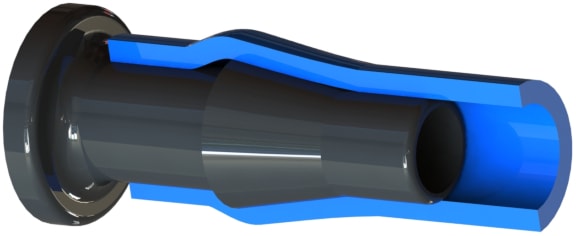
Cross-section of flexible tubing pushed over a hose barb
Why use hose barb connections on inline fuel filters?
Fittings, including inline fuel filters, use hose barb connections because they have a simple design and are relatively easy to connect and disconnect. The resulting connections are extremely resistant to blog-off and pull-off. When installed correctly, hose barb connections also create especially leak-resistant seals.
During installation, a hose barb is pushed into a tubing end to make a connection. This causes the tubing to stretch to fit over the barb. On the other side of the barb’s sharp edge the tubing relaxes around the shank of the barbed connection.
It is the hose barb’s sharp edge that grips and hangs onto the inside surface of the tubing hose. Any force pulling against the hose barb’s grip will cause the diameter of flexible tubing to shrink and grip the barb edge even tighter.
In addition to creating a strong attachment, hose barbed connections are very leak resistant. This leak resistance is provided by the contact seal made between the smooth surfaces of the barb slope and barb shaft with the smooth inner surface of the flexible tubing or hose. The result is a fuel-tight connection.
Does it matter what type of fuel line (hose or tubing) is used with hose barbed fuel filters?
Plastic inline fuel filters with hose barb connections (barbed inserts) are designed to work with flexible hose and plastic tubing specifically designed to carry fuel. Flexible fuel lines for gas-powered internal combustion engines need to be compatible with hydrocarbon fuels and oils. It is especially useful if they are also resistant to gasohol (gasoline-ethanol blends).
In addition to chemical compatibility with widely available fuel mixtures, flexible fuel line hoses and tubing need to be soft enough that hose barbs can grip the inner surface of the fuel line yet elastic enough to form a fuel-tight surface seal on the barb shaft.
Engine and machine designers are familiar with durometer ratings and choose the appropriate fuel line durometer for barbed connections. Fuel filter manufacturers will also recommend the best tubing durometer for the barbs on their filters.
OEM fuel filter manufacturers frequently specify a specific fuel line ID for the hose barbs used on each of their filters. And OEM filter makers usually design fuel filters with different barb sizes. This allows for a choice of fuel filters to help match with the specified fuel line inner diameter.
Learn more about what durometer is and why it matters at the ISM blog >>
Most manufacturers of quality original equipment, if they provide pre-installed hose barbed plastic inline fuel filters, install them with properly sized spring band clamps to ensure durable leak-free connections. This type of clamp is selected because it can compensate for fuel line compression around the barb shank and the expansion and contraction caused by temperature variations.
How do you know when plastic fuel filters are dirty and should be replaced?
Clogged fuel filters interfere with fuel flow to an engine. This usually makes them a good starting point when diagnosing fuel flow problems.
Some common symptoms of clogged or dirty inline fuel filters
- Engine misfiring
- Damaged fuel pump
- The engine is hard to start
- Significant drops in engine power
- Engine stalling when a load is put on it
Obviously, symptoms like these can also be caused by other problems with the engine or its fuel system. Nevertheless, the relatively low cost of plastic inline fuel filters makes replacing them a practical, fast and potentially easy solution. Engine owners tend to keep at least one spare fresh filter available for this reason.
Choosing an original equipment (OE) or replacement plastic fuel filter with a clear or semi-transparent body will make it easier to tell when a filter is approaching the end of its useful life. The filter element appears noticeably dirty if clogging is a problem.
For powersports and outdoor power equipment, the best practice is to change out fuel filters at the beginning of the next season after being in storage. Another good way to approximate the time between fuel filter replacement is the number of hours of use. If available, this information is usually provided in the machine’s user manual or other user support information.
Remember to always refer back to the owner’s manual before performing engine maintenance. For maintenance beyond your experience or skill level, always consider bringing the machine either to the dealer where it was purchased or a shop that specializes in small engine maintenance or repair.
Are plastic fuel filters safe?
One of the major advantages of using high-quality OEM and OE replacement plastic fuel filters is the quality of the body materials used. OEM and OE replacement parts use engineering plastics instead of much cheaper commodity plastics. These engineering plastics are chosen, formulated and manufactured to withstand powersport and outdoor power equipment real use conditions without failing. This removes a considerable amount of uncertainty about whether a plastic fuel filter might fail suddenly and catastrophically. Compliance with ANSI/OPEI B71.10 testing standards provides a greater assurance of quality and durability.
ITW Visu-Filter plastic inline fuel filters and ANSI testing standards
ITW Visu-Filter plastic inline fuel filters comply with the ANSI/OPEI B71.10-2018 standard. Visu-Filter fuel filters are made in North America at ITW Fastex Filtration and ITW Powertrain Components manufacturing sites. ITW is an OE and OEM supplier of automotive-grade components and sub-assemblies. Their automotive customers include major automobile and truck manufacturers and their tier suppliers.
Some notes about replacing hose barbed plastic fuel filters
Should you replace flexible fuel line when you replace plastic fuel filters?
Flexible tubing or hose used for fuel lines is stretched when installed onto a fuel filter's hose barb connection. Over time, the inner diameter of this section of the fuel line becomes permanently expanded. There will also likely be some scoring of the fuel line's inner surface when the fuel line is pulled off the old filter’s barb. For both these reasons, this section of the fuel line will probably no longer be able to provide a good, leak-proof seal.
Why would you need to replace the fuel line?
A best practice is to cut off the used section of the fuel line where it has previously been installed over a hose barb. In many cases, especially with small engines, the remaining fuel line may not be long enough. If this is the case, replacing one or both fuel line segments on either side of the fuel filter may be necessary.
Plastic fuel filter replacement and routine maintenance
Periodic filter replacement can be used as a maintenance reference point. Users often opt to replace the relevant fuel line segments each time a fresh hose barbed fuel filter is installed. This guarantees the best, most leakproof seals between the fuel line and the fuel filter's hose barbed connections. It also ensures that fuel lines are much less likely to fail from aging or wear.
Some tips on how to connect hose barbed fuel filters to fuel lines
I hope you find this postscript useful. It is a quick how-to for installing fuel filters with hose barb connections.
For proper installation, the outer diameter (OD) of a fuel filter hose barb, at or close to its tip, needs to be larger than the fuel line’s inner diameter (ID). Expect some resistance when the barbed connection is inserted into the tubing.
A correctly sized fuel line needs to stretch to fit over a barbed connection. On the hose barb’s far side, behind the barb’s sharp edge or line contact, the fuel line should shrink back to its normal size. This is where the fuel line’s inner surface forms a fuel-tight surface contact seal with the barb shank. The shank is the cylinder-shaped section between the barb’s sharp edge and either a barb stop or the fuel filter body.
Hose barb connections are an excellent choice for inline fuel filters because they are very resistant to pull-off and blow-off yet relatively quick and easy to install and uninstall without the use of hand tools.
1. Choose the right tubing or hose
- Use a fuel line with an inner diameter (ID) recommended by the fuel filter manufacturer.
- Choose a fuel line durometer appropriate for hose barb connections. 85 Shore A is usually about right.
- Choose flexible plastic or rubber tubing or hose formulated to carry hydrocarbon fuels and lubricants as well as gasoline-ethanol blends (gasohol).
Learn more about what durometer is and why it matters at the ISM blog >>
2. Cut the tubing or hose
- Cut the tubing or hose so that it has a clean, square edge.
3. Clamps
- Constant tension spring band clamps are usually best.
- If possible, size the clamp for the tubing or hose outer diameter when it is installed on the barbed connection. If an exact match is not possible, a good rule of thumb is to choose a clamp where the fuel line’s outer diameter is at about the middle of the clamp's size range.
- If there is a choice of clamp band widths available and space allows, consider choosing a clamp that has wider bands. Wider clamp bands have more surface area in contact with the fuel line. This can help reduce the possibility of leaks.
- Slide the clamp over the fuel line. Ensure it is far enough away from the end that it will not interfere with the filter’s barbed end when it is being pushed into the fuel line.
4. Insert the fuel filter hose barbed connection into the fuel line
- Start by pushing the tubing onto the sloped surface of the barb. While firmly holding the fuel line, push the barb edge firmly on into the tubing.
- Twisting the filter back and forth while pushing the barb into the fuel line may make things easier but avoid using a screwing motion. "Screwing" the barb into the fuel line could create a spiral leak path on the inner surface of the tubing or hose and this could lead to a fuel leak.
- Once the fuel line’s end is past the barb edge, push the fuel line over barb’s shank (the cylindrical section behind the sharp barb edge). Continue pushing the fuel line along the hose barb shank until the end of the fuel line bumps up against either a tube stop (tube end stop) or the filter body.
5. Position the clamp
- Squeeze the clamp ears to expand the clamp and then slide it toward the fuel filter body.
- Allow the clamp to contract and grip the fuel line only when it is entirely past the barb’s sharp edge. This will help prevent the barb edge from cutting the inner surface of the fuel line. This can help prevent fuel line failures or tears.
If articles like this interest you..., please consider subscribing to our blog. You'll receive an email notification whenever we post a new article.
Other related blog posts
-
Screen vs. Paper Fuel Filters for Small Engines >>
Expensive small engines doing tough jobs need the right fuel filter. Which type of filter is better, paper or screen? The answer is "it depends." Fuel flow and other factors determine which kind to use and where to put it.
-
ANSI/OPEI B71.10 Compliant Fuel Valves and Filters >>
The ANSI/OPEI B71.10-2018 standard went into effect 12-Nov-2020. Learn more about ANSI-compliant plastic fuel filters and fuel shut-off valves. Find out how independent, third-party testing in certified labs confirms both materials and manufacturing quality by exposing critical fuel system components to stresses that mimic real-world operating conditions.
-
Sintered Porous Bronze Fuel Filters, Part 1 - What They Are and Their Use in Small Plastic Inline Fuel Filters >>
Why bronze filter elements for plastic inline fuel filters? Find out more about sintered porous bronze filter elements and their use in small plastic inline fuel filters. ANSI/OPEI B71.10-2018 compliant Visu-Filters use them. ITW Fastex Visu-Filters for light-duty carbureted vehicles, Outdoor Power Equipment and Powersports.
-
Sintered Porous Bronze Fuel Filters, Part 2 - How Porous Bronze Filters Are Made and How They Work >>
Details about how sintered porous bronze filter elements are made and how they work: porous bronze particle capture, filter element sintering, small inline filter backwashing, small filter installation and what small filter quality means. ANSI/OPEI B71.10-2018 compliant ITW Visu-Filters use sintered porous bronze filter elements.
-
Sintered Porous Bronze Fuel Filters, Part 3 - An FAQ, the Sintering Process and Other Applications >>
An FAQ about depth filtration, porous sintered bronze filter elements and details of the sintering process. Plus, a section about other applications for porous sintered bronze beyond filtration and a list of references used for this three-part article series.
Are you developing a design for or maintaining a small-bore air, gas or fluid system? Then ISM has the fitting or component for it.
The ISM catalog includes
- Product specifications
- Photos and 3D CAD images
- Links to product pages in our e-commerce catalog
Check out our complete lineup of miniature fittings and components >>
Keep in mind we carry thousands of related items like valves, connectors, adapters, gauges and so on.

